5-6 Days in Tokyo Itinerary: Complete Guide for First-Timers
What to include on your 5 – 6 day Tokyo itinerary so it isn’t a cookie-cutter of everyone else’s? Having visited Japan’s capital over a dozen times throughout the past decade, I’ve experienced more than the average tourist and know exactly where to “blend in” to avoid crowds!
The task of narrowing down the plethora of options for things to do can seem like a daunting task – but it doesn’t have to be with my customisable itinerary for spending 5 or 6 days in Tokyo to help you create a trip that’s just right for you.
In this itinerary I’ll share the best places to visit in Tokyo for first-timers, as well as some lesser-known alternatives that offer similar experiences for a break away from the tourist crowds.
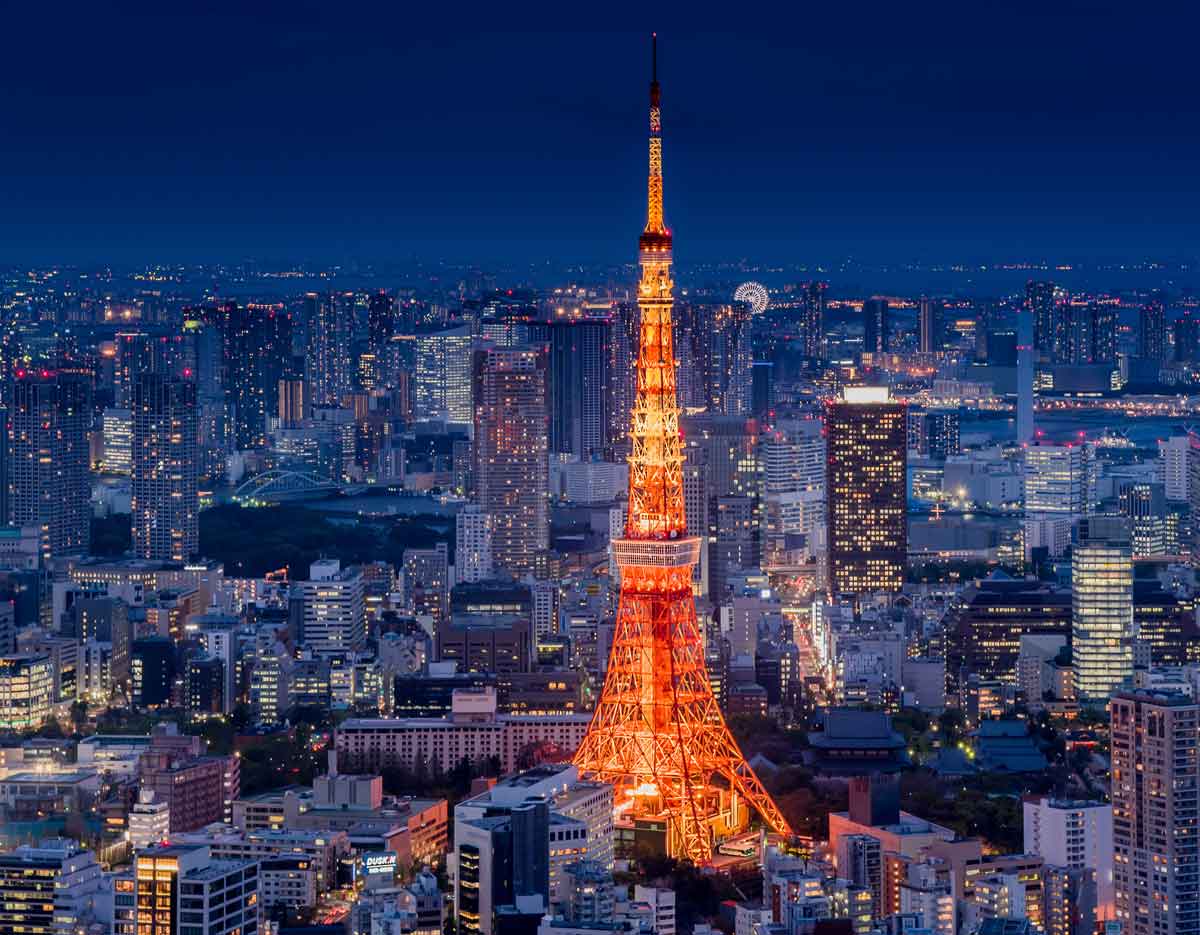
How many days to spend in Tokyo will depend on the time you have available and your interests, so I’ll share some day trip options (including Mt Fuji) to make this Tokyo itinerary 5 days or 6 days – the choice is yours.
Are you ready to visit Tokyo for the first time? Get ready to place yourself amongst the bustling city streets, tranquil landscaped parks, stunning panoramic vistas, cultural experiences, foodie adventures and remarkable history by reading on for more!
This post contains affiliate links, at no extra cost to you. I may earn a small commission if you click through and make a purchase.

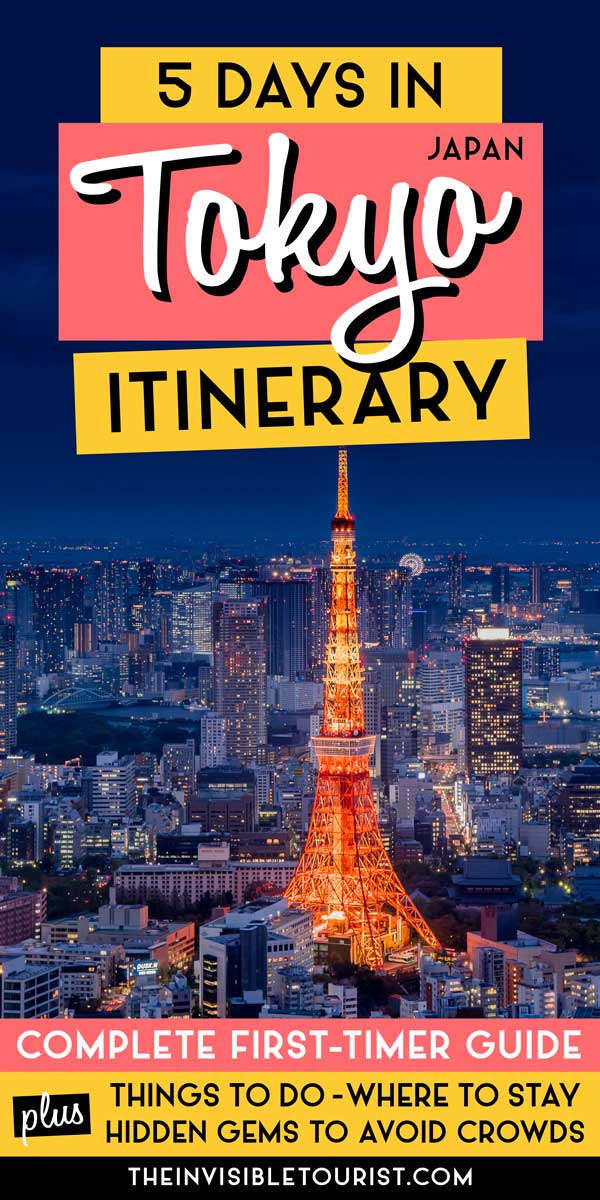
TIP: This dedicated Tokyo guide is part of my full 2 Weeks in Japan Itinerary, 3 Weeks in Japan Itinerary, and my Japan honeymoon itinerary. Tailored especially for mid range travellers visiting for the first time, be sure to check them out as they each cover many of these beautiful places to visit in Japan.
Complete 5 – 6 days in Tokyo itinerary for first-time visitors
Tokyo is larger than New York City, so it’s important to know how to get around by public transport. It’s easy to navigate once you know, so I’ve got you covered!
DAY 0: Transit
Allow this day to be your transit day. Arrive, settle into your hotel and maybe take a look around the area to get your bearings. Tomorrow we begin!
How to get to Tokyo from Haneda Airport
Haneda is a suburb within Tokyo, it’s much closer to the city centre than Narita. If you have the option I’d recommend arriving here.
- Getting there: Haneda Airport to Tokyo (Hamamatsucho) via Tokyo Monorail, 15 minutes.
- Cost: Adult JPY 500 ea
- Your IC/Suica Card will cover the cost of the monorail, too! It’s easy to pre-purchase your Suica card to redeem on arrival so you’re ready.
How to get to Tokyo from Narita Airport
Narita is located in nearby Chiba Prefecture, further away from central Tokyo.
- Getting there: Narita Airport to Tokyo via Narita Express, approx. 1 hour.
- Cost: One way Adult Narita Express ticket JPY 3,250 ea
- A popular option is also the Narita Airport Limousine Bus. It’s almost half the cost of Narita Express, you’re able to book Narita Airport Limousine tickets in advance.
TIP: My guide to Japan train symbols and their meanings in Google Maps will help you know where and when you can use different transport cards and passes.
Near Haneda Airport is my favourite hidden shrine dedicated to aviation safety, Anamori Inari-jinja.
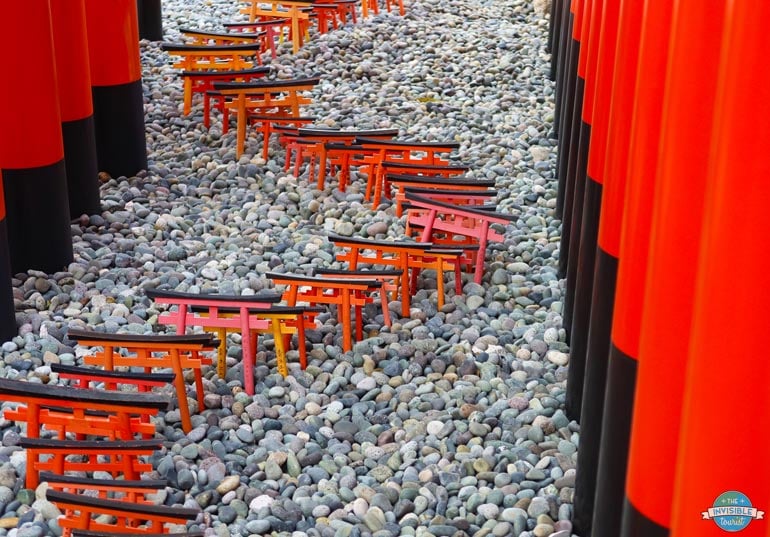
DAY 1: Shibuya & Harajuku
Their neighbourhood borders melding together, Shibuya and Harajuku are two of the busiest areas in Tokyo. I’m going to share the things to see and do in each, but these days I don’t recommend Harajuku for invisible tourists – it’s not the same as it was a decade ago.
Jump to my Harajuku alternatives down the page if you think this area isn’t suitable for you.
Things to do in Shibuya
TIP: Read my comprehensive guide to things to do in Shibuya during the day and night for detailed info on what I’ve summarised here!
- Spend your morning discovering Shibuya 渋谷 by meandering across the famous Shibuya Scramble Crossing. It’s the world’s busiest street crossing with 3,000 people using it at any one time! Sunset timeslots at Shibuya Sky are difficult to secure, for fewer crowds head up during the day to see Tokyo from above (read my Shibuya Sky tips for visiting to not make the same mistakes I did on my first visit).
- Seek out the Hachiko Statue located just outside the station. He’s hard to miss with the swathes of tourists surrounding him for a photo! Hachiko’s story began in the 1930’s and is a touching one. This loyal dog would journey to the station each day to greet his master when returned home from work. He was so loyal he continued to do so even after his owner passed away. After Hachiko’s death, this statue was built in his memory and is a popular meeting place in Shibuya.
- Shopaholics can shop up a storm in the nearby fashion stores, most notably Shibuya 109 directly opposite Shibuya Crossing. There’s actually way too many stores for me to name so trust where your feet lead you in this area, you won’t be at a loss!
- From here, make your way over to Takeshita-dori, Harajuku 原宿 and spend the afternoon exploring. Takeshita-dori is directly opposite JR Harajuku station. The funky balloon sculptures on the entryway sign are constantly changing! Wander down through the quirky shops to find cosplay outfits, unusual sunglasses, bags, clothing, and anime favourites.
- The evenings come alive at Nonbei Yokocho, a narrow alley beneath the railway tracks lined with local izakaya and little bars to meet locals.
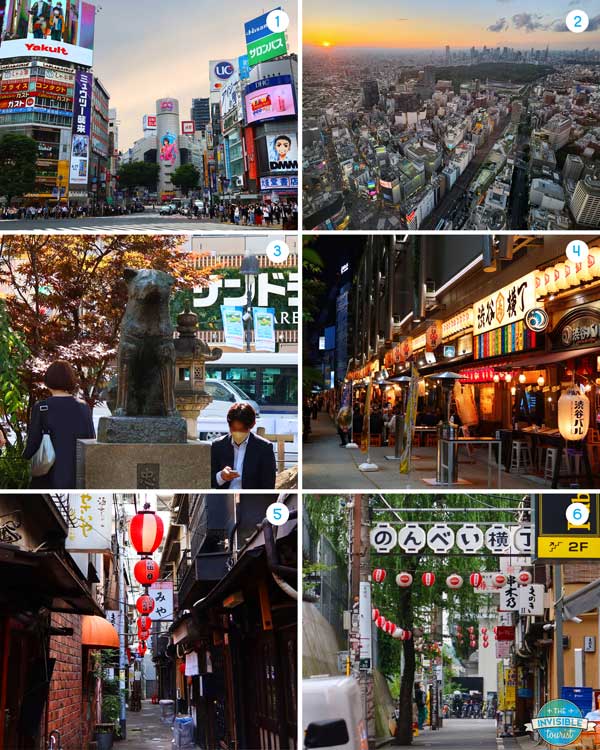
Things to do in Harajuku
Harajuku is famous for Takeshita Street, lined with quirky fashion, second-hand clothing stores, Hello Kitty anything, rainbow street food and cafes where teens and tourists frequent.
Trendy Harajuku Girls who dress in alternative clothing, their hair dotted with dozens of clips and bright coloured statement accessories don’t hang out in Harajuku these days (try Shimokitazawa or Sugamo instead, more info down the page).
- Keep your eye out for kawaii (cute) items in the boutiques and indie fashion stores on Cat Street. Oh, have you even been to Harajuku if you haven’t tried the popular crepes here?
- If you pass the Tokyu Plaza building, make sure to get a shot of the crazy mirror entrance.
- Do you enjoy shopping for designer labels? Then don’t miss Omotosando street, lined with brands from Gucci to Dior and Chanel.
- TIP: There is a small, hidden teamLab and Sanrio experience in the Samsung Galaxy Harajuku building on Level 4. It’s not well-known but will keep little ones busy away from crowds for an hour or so. Parents can take a break in the cafe afterwards.
- If shopping is not your thing and you’re over the hustle and bustle, head to Meiji Jingu (Meiji Shrine) Tokyo’s major Shinto shrine dedicated to the souls of Emperor Meiji and his wife who ruled Japan from 1867-1912. The grounds are so lovely to stroll around as over 100,000 trees were donated from across Japan! You can also visit adjoining Yoyogi Park, famed for early-blooming cherry blossoms.
- To get off the beaten path in Harajuku, head north of Meiji Jingu to Togo Shrine, a hidden gem often overlooked by first time visitors. With a peaceful carp pond and lovely landscaped gardens the shrine celebrates Heihachiro Togo, the Japanese Navy admiral who led Japan to victory defeating Russia in the Russo-Japanese war (the first non-Western admiral in history to do so).
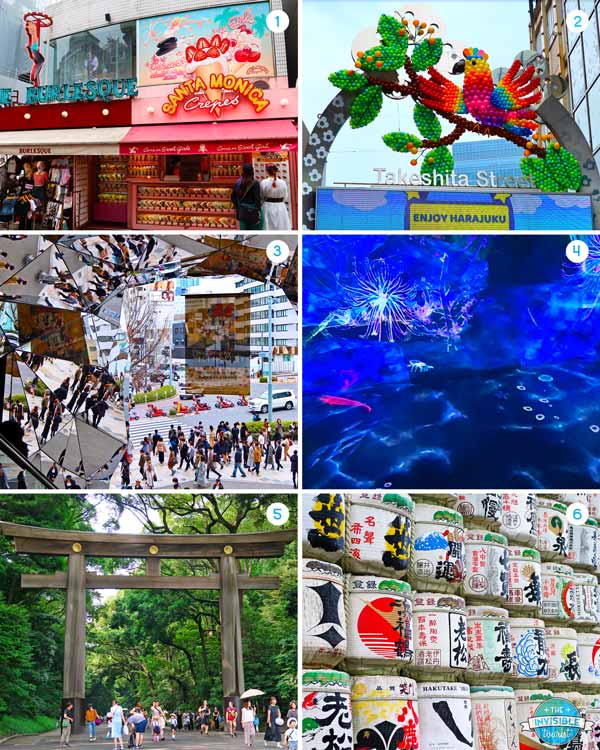
Where to eat in Harajuku
These are the popular tourist spots if you’re wanting to bypass them:
- Pastel fairy floss bigger than your head at Totti Candy Factory and visit Le Shiner for rainbow grilled cheese sandwiches.
- If trying famous Japanese soufflé pancakes is up your alley, Happy Pancake is for you! (I went to Happy Pancake in Hiroshima and it was amazing).
- Although the selection of fillings look overwhelming, treat yourself to some incredible crepes at Santa Monica Crepes.
Alternatives to Harajuku
These days, Harajuku is not what it is remembered for from 10ish years ago. It’s become quite touristy, overcrowded with touts trying to coax shoppers to buy fake designer bags, and international franchises lining Takeshita-dori.
For alternative retro places in Tokyo to visit, head to:
- Jizo-dori in “Grandma’s Harajuku,” Sugamo. Here you’ll find tea shops, traditional candy stores, indie shoes and clothing stores, small fruit and veggie markets, specialty stores, no crowds and a much more local feel.
- Sangenjaya with its gorilla hanging from the rooftop of a Family Mart has a similar local vibe, and nearby in Setagaya is Gotoku-ji, the “Lucky Cat” temple.
- The Shimokitazawa neighbourhood is more like the old Harajuku you’d expect, and where Tokyo’s cool kids now hang out.
- I also think Rikugien Gardens in Bunkyo is a beautiful, less-crowded garden which you may prefer if you’re not into touristy areas.
Here are photos from these spots:
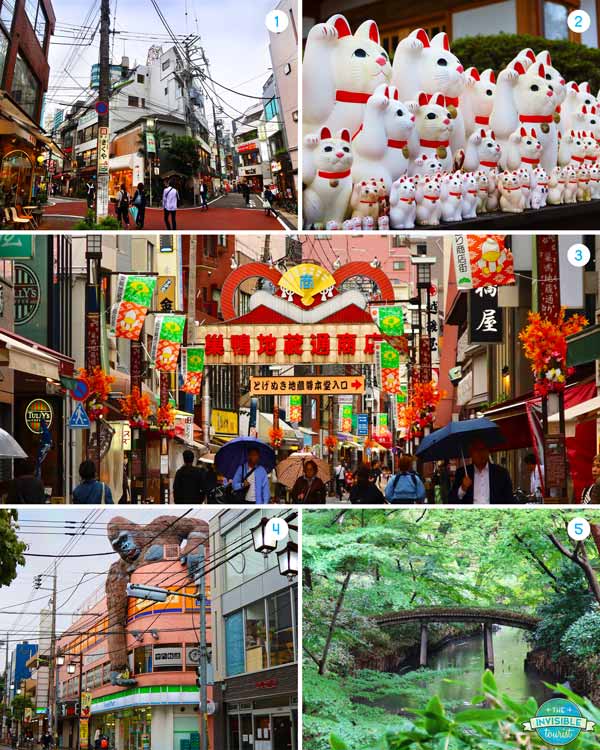
DAY 2: Shinjuku
Prefer to skip the crowds and touristy spots of Shinjuku? Jump down the page to my Shinjuku alternative.
Things to do in Shinjuku
If you thought Shibuya was massive, prepare to be blown away by Shinjuku. Shinjuku 新宿 Station is actually one of the things Japan is famous for as it’s the busiest in the world, and it’s easy to see why when you’re there! Some 3.6 million passengers use this station each day and there are over 200 exits. Really!
At the East Exit, you’ll hear Shinjuku no Nekomae, the resident cat on a new 3D TV. He’s quite mischievous, I spent a good half hour watching his antics!
If your experience at Shinjuku station felt a bit hectic it’s an easy escape to Shinjuku Gyoen National Garden for a slice of tranquility in the busy city, more on this and Shinjuku’s Golden Gai below.
Shinjuku Gyoen is one of the popular places to go in Tokyo for locals to view cherry blossoms at the beginning of spring. It’s known for its three distinct styles throughout the grounds: Japanese, French and English gardens. It’s so lovely sitting in the sun on the lawns in the afternoon!
TIP: In the streets surrounding the park, if you’re up for a spot of shopping there’s major department stores such as Takashimaya, Isetan and Keio to choose from.
Try to find Godzilla hanging out by the Hotel Gracery and spot the famous flashing neon lights of Kabuki-cho (it’s one of Tokyo’s iconic streets). Into second-hand designer goods? There are numerous boutiques in Shinjuku selling authentic pre-loved items for great prices.
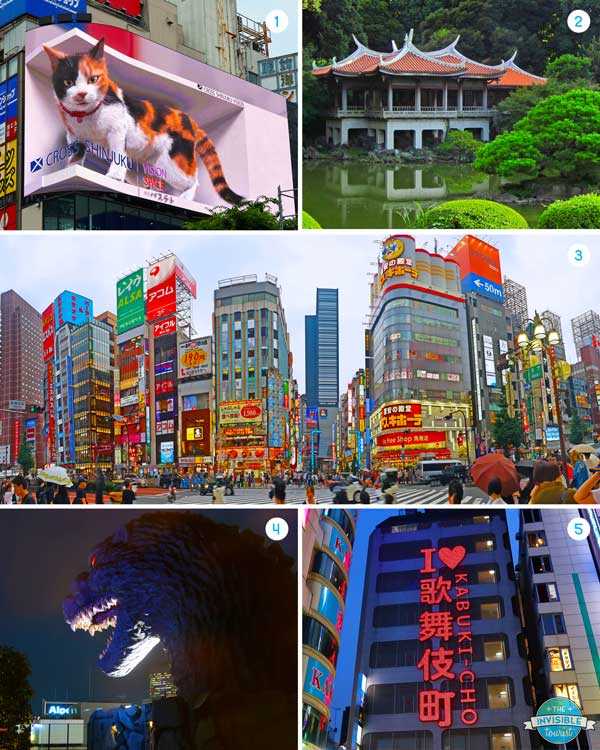
TIP: Most other itineraries will suggest visiting the Tokyo Metropolitan Government Building here for free views over the city. I personally don’t recommend this as most free things draw huge crowds of tourists! Plan to visit early if you’re wanting to do this.
NOTE: Shinjuku, particularly the Kabukicho red-light area, is home to plenty of girls’ bars. Street touts may try to stop visitors walking past to coax them in. This is usually a bad idea as these bars are known to claim drinks are free, however will charge an extortionate price when visitors want to leave. To truly be an invisible tourist, just ignore these folks and keep walking.
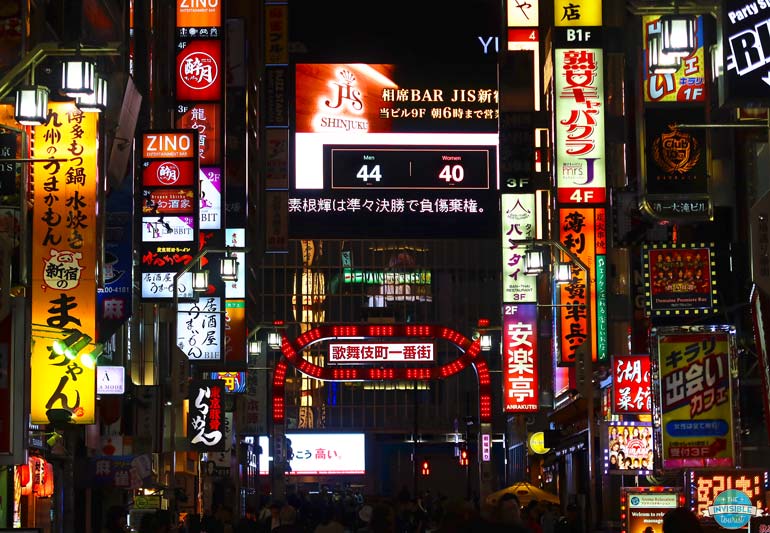
TIP: If you’re hoping to visit during the cherry blossom season, my detailed guide to spring in Japan is packed with tips for more places to go, alternatives to popular spots, what to pack and how to avoid the huge crowds!
Where to eat in Shinjuku
There are a few popular areas for a Shinjuku culinary experience, albeit they have become a bit touristy in recent years. Remember my reviews of food tours in Tokyo to help you get away from the popular spots:
- Golden Gai 新宿ゴールデン街: This compact “Golden District” is home to over 200 small bars and comes alive at night. By “small” bars I mean they only seat up to 8 customers at a time in some cases!
- Omoide Yokocho 思い出横丁: Also known as “Memory Lane”, you can expect to find small laneways filled with ramen, soba, sushi and yakitori eateries. The tunnel at the lane’s entrance created by the train tracks above gives it the awkward nickname “Piss Alley”. The lane is decorated with seasonal artificial plants or flowers. Please note that smoking is allowed in these restaurants. This is becoming more touristy though as it’s starting to cater towards visitors rather than locals.
- Kabukicho Tower is a new addition to the Tokyo skyline and features several floors of eateries and funky dining options. My secret favourite is the 2D Café, though!
- Finally, get your night started at the hilariously entertaining Samurai Restaurant ロボットレストラン (formerly the Robot Restaurant and now 18+). While this is one of those touristy things, it’s so crazy you can’t help but enjoy it. Just the waiting room has enough bling to give you a sensory overload!
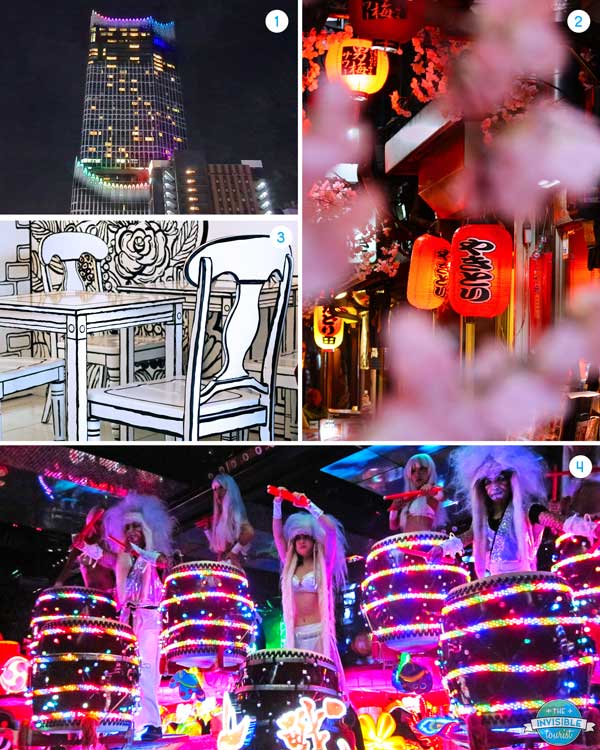
Alternative to Shinjuku
With dozens of izakaya (Japanese-style casual pubs) established in hollowed-out arches beneath the railway tracks, Shimbashi makes a more local alternative to Shinjuku (or Shibuya).
Loved by salarymen and located near the Minato area, Shimbashi is a fun night spot without the size that can make Shinjuku feel overwhelming. Try this Hidden Gem Food Tour in Shimbashi with a local to show you the ropes.

DAY 3: Yanaka, Akihabara & Asakusa
On day 3 of this 5 days in Tokyo itinerary, I’ll provide some options for you to mix-and-match the popular and lesser-known spots that suit your interests.
Let’s take a look at the things to do in the Yanaka, Akihabara and Asakusa areas. Select either Yanaka or Akihabara depending on your preferences, and you’ll see why I suggest Asakusa as today’s last stop.
Things to do in Yanaka Ginza
One of Tokyo’s cat-loving neighbourhoods! Surviving the Great Kanto Earthquake of 1923 and the firebombing of Tokyo during WWII, Yanaka Ginza is a special, preserved neighbourhood with old-world charm.
Sample different local specialties at the bakeries, visit artisan stores including knives, leather goods, clothing, coffee, and enjoy the different little cafes and bars.
TIP: A local can show you around on this Yanaka foodie tour I personally enjoyed, read my Old Town Tokyo review here for more!

Things to do in Akihabara
Akihabara 秋葉原 is known as “Electric Town” for its amazing variety of electronics. You’ll also be inundated with anime figurines, video games from any era and every electronic gadget you can think of. If you can’t find what you’re looking for in Akihabara, I’m pretty sure it doesn’t exist!
TIP:Anime lovers will also enjoy this anime and gaming adventure tour around Akihabara.
TIP: Nakano Broadway is a popular spot for anime merchandise too. Just know your prices beforehand because I’ve seen plushies cost more there than from the actual Pokémon store in Nihonbashi (near Tokyo Station).
Finally, if you’re an anime fan you’ll want to visit Kanda-jinja (Kanda Myojin Shrine). It’s been featured in anime such as Love Live! and is over 1,300 years old. Pick up the most unique omamori here! Keeping in with the electronics theme of the neighbourhood, this lucky charm is believed to protect your gadgets from viruses and shutdowns.
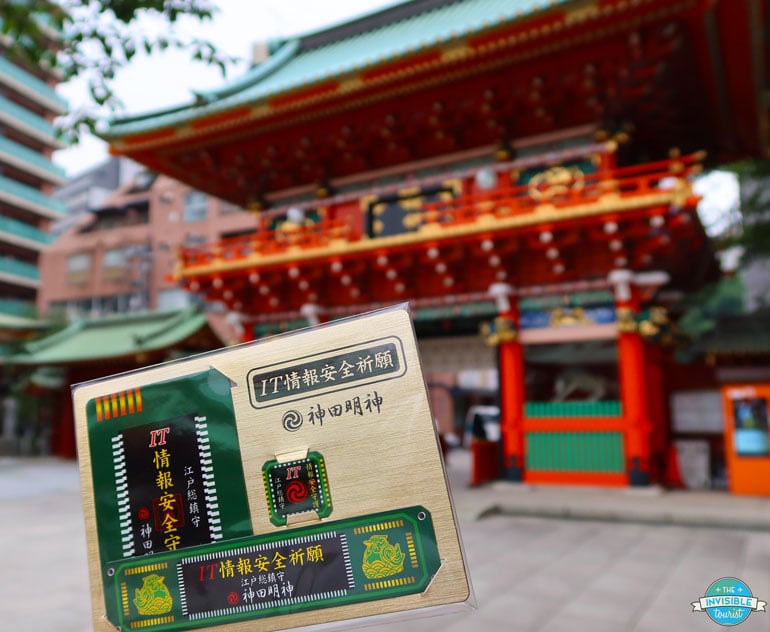
Have you ever wanted to meet a geisha? You don’t need to go to Kyoto! Learn 6 traditional skills and Japanese culture from her at this Tokyo geisha experience on the grounds of Kanda Shrine (book in advance here), and more traditional experiences like this down the page.
TIP: If you’re in the mood for some nostalgia, don’t miss Super Potato. Spread over several levels this store is jam-packed with toys, gifts, memorabilia and everything else to do with your favourite video games from the 80’s and 90’s.

Maidreamin’ was an interesting yet awkward experience for me but there are many other themed places around town… Dungeon, Alice in Wonderland, Ninjas, the list goes on! More info and pricing for Maidreamin’ experience in Tokyo here.
NOTE: Here on my Tokyo travel blog, I don’t recommend animal cafés in Japan as animal welfare risks are well known. For instance, in recent years several owl cafés have shut down due to mistreatment of the birds. If you really want to visit an animal café in Tokyo and beyond, please do a little research first to seek out some ethical options.
Things to do in Asakusa
I’ve saved this for last for a reason… Discover Tokyo’s oldest temple in Asakusa 浅草. Senso-ji is Asakusa’s main attraction, dating back to 645 AD. Although destroyed in the firebombing of Tokyo during WWII (you can still see burnt scars on the trees here), it was rebuilt after the war so this beautiful piece of history can be enjoyed by everyone today.
To avoid crowds, the best time to visit Senso-ji is at night. The shops along Nakamise-dori are closed, but it’s a trade-off. To make up for it on the way to Asakusa, stop off at nearby Kappabashi “Kitchen Town” for kitchen utensils (and anything to do with cooking) for unique souvenirs.
TIP: Be sure to enter onto this iconic street via the Thunder Gate — don’t forget to look beneath the lanterns — I explain on my Instagram here.
TIP: For a view over Nakamise-dori and Senso-ji’s pagoda, visit the 8th floor of Asakusa Tourist Information Centre. This is free, and the view of the SkyTree and the “Golden Poop” is amazing. A word of advice though – go super early to avoid crowds! More details on my Instagram here.
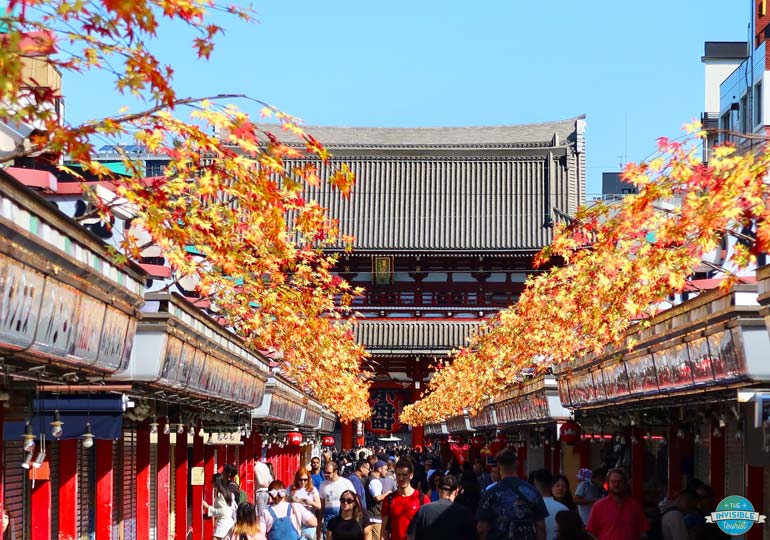
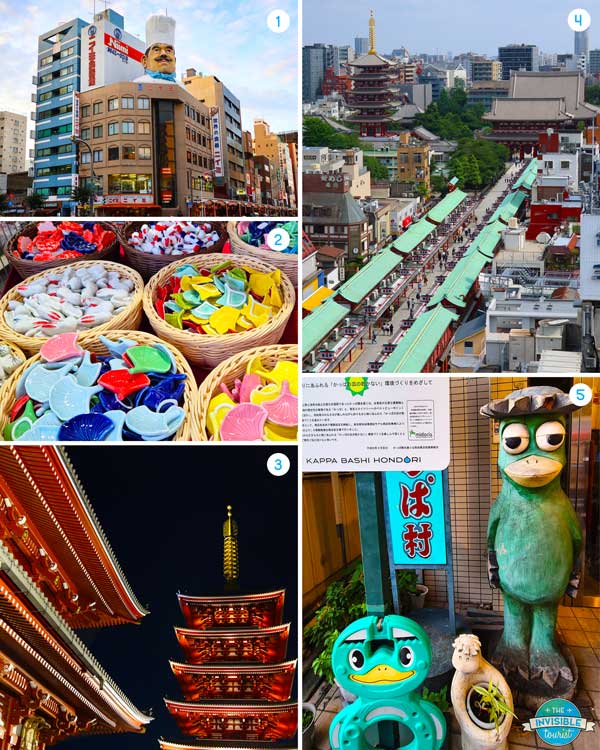
A fun cultural thing to do at Senso-ji is to find out your fortune with omikuji おみくじ. To receive your fortune, simply make an offering to the temple (JPY 100 – 200).
Make a wish whilst gently shaking one of the omikuji containers until a stick marked with a number falls out of the small hole. Then, take an omikuji sheet of paper from the corresponding numbered drawer that’s on your stick. If it’s a good fortune, keep it! If it happens to be bad, fold and tie it as others have done nearby. Maybe you’ll receive better luck next time!
TIP: The numbered sticks and drawers are written in traditional Japanese characters, so knowing what to look for will help you collect the correct fortune! I’ve done the hard yards for you below, but be sure to check my handy guide to Japanese for tourists for more.
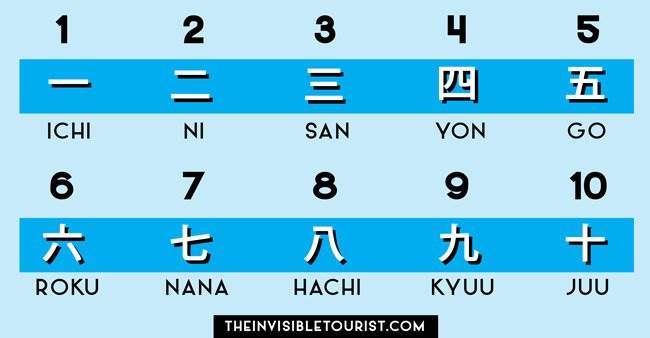
TIP: Tucked away behind Senso-ji are two more shrines that are often overlooked by tourists. Find out what they are in my guide to Tokyo’s hidden gems.
Cultural experiences in Asakusa
Consider a small group tour with a local guide to maximise your experience:
- Asakusa kimono photography tour →
- 5 hour Asakusa, Tsukiji Fish Market & Aakihabara highlights tour →
- 5 hour Edo & hidden gem cycling tour in Asakusa & surrounding areas →
- Asakusa cultural walk & matcha making tour →
- Private zazen meditation in a temple with matcha & sweets →
- Seasonal kaiseki lunch with optional geisha entertainment →
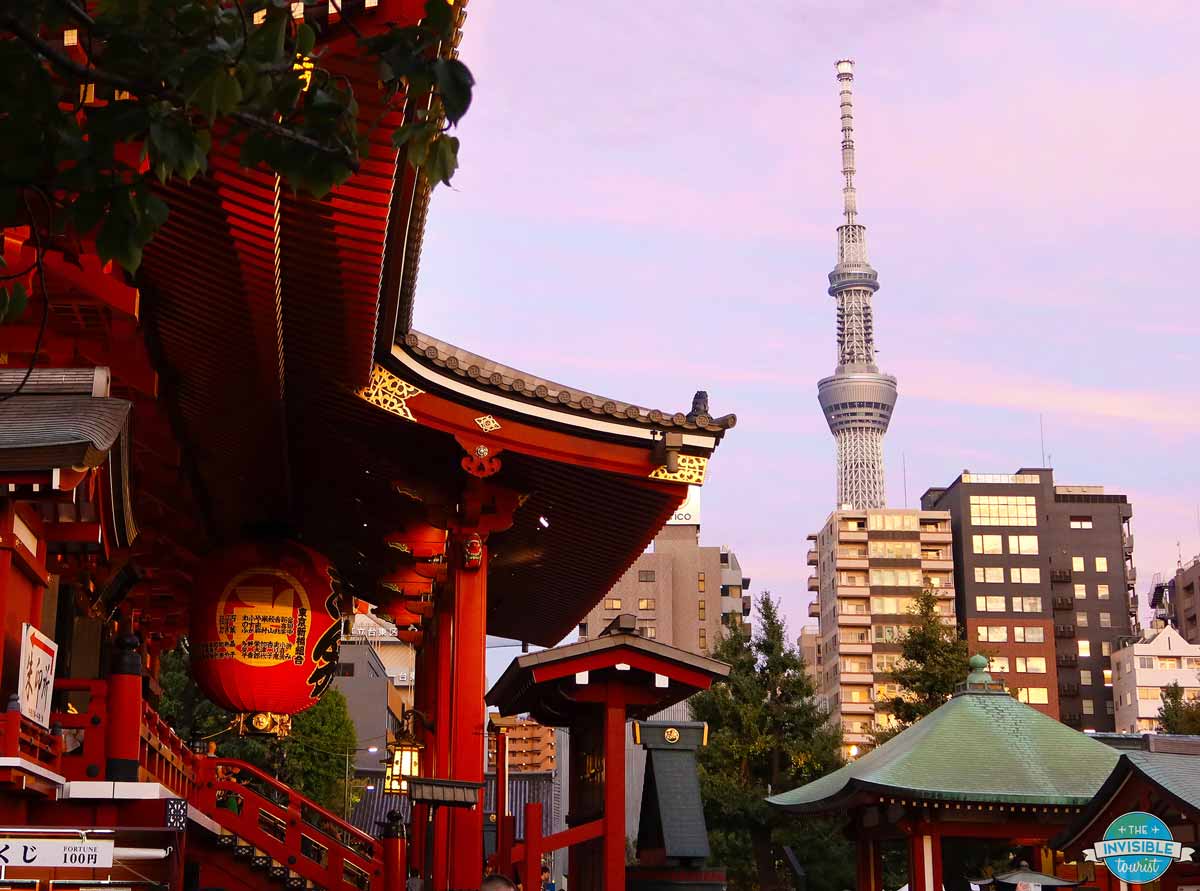
DAY 4: North-Eastern Tokyo – Sumida & Ueno
Tokyo SkyTree
On day 4 of this Tokyo 5 day itinerary, make the trip up Tokyo SkyTree 東京スカイツリー to really appreciate the immense scale of this city, it’s sure to leave you awe-struck. If the weather is on your side, you may get to see Mt Fuji in the distance.
There are loads of shops and restaurants at the top of the SkyTree. It would be easy to spend an entire day just there alone! The Tokyo SkyTree is one of the most famous landmarks of Japan. Info on more types of SkyTree tickets here.
NOTE: There’s a free observation deck at Tokyo Metro Government Offices, located in south-western Shinjuku if you can’t get enough of Tokyo from above. Keep in mind though, it’s usually very crowded because it has free entry.
TIP: You can now walk from the Tokyo SkyTree to Senso-ji in Asakusa in 18 minutes, thanks to the new Sumida River Walk! As the name suggests, find trendy shops and restaurants along the river here as you enjoy this stroll to Asakusa.
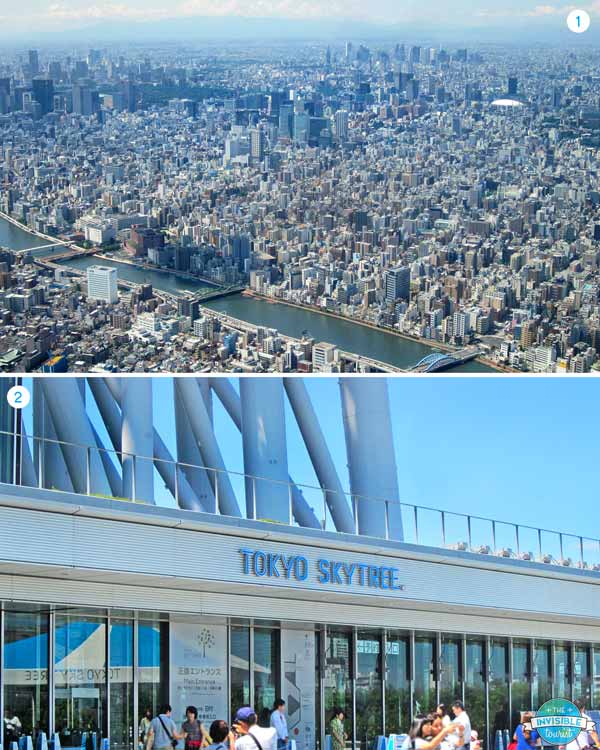
Sumida Hokusai Museum
A place I don’t see mentioned often and a perfect rainy day Tokyo activity is the Sumida Hokusai Museum. As a long-time lover of this master’s woodblock prints, I was very impressed with the permanent exhibition.
Even if you’re not into art, you’re sure to recognise and appreciate the famed “Great Wave Off Kanagawa” piece that is synonymous with Japan!
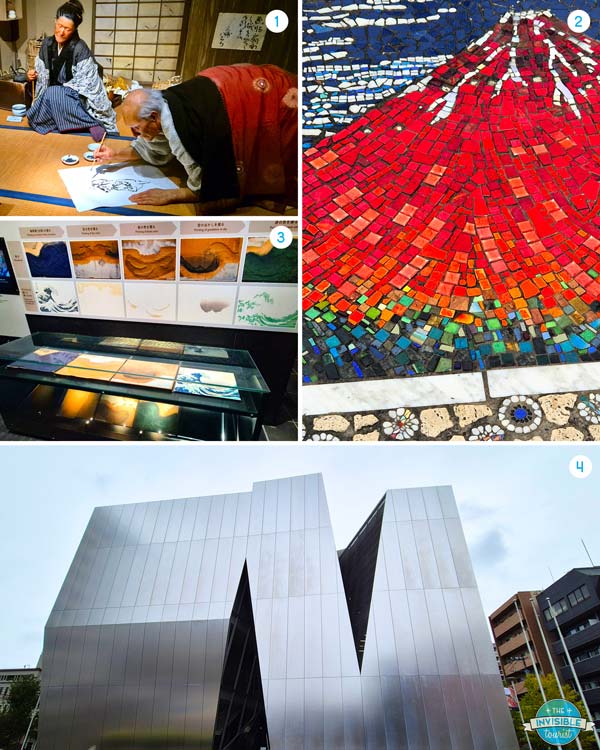
Ueno Neighbourhood
Ueno is an underrated Tokyo neighbourhood. Grab a bite to eat beneath the railway tracks at Ameya Yokocho, an amazing open-air market with everything from street eats to cheap souvenirs.
After you’ve had a snack, make your way to Ueno Park for a relaxing afternoon stroll around the gardens. It’s incredibly popular for seeing sakura during spring, but there are some lovely shrines tucked away within the grounds.
Don’t miss the stunning details of Toshogu Shrine and peep through the circular branch of the beloved “Moon Pine” at Kiyomizu Kannon-do. Lastly, witness the beautiful Bentendo Temple overlooking the pond (& hire a swan paddle boat if you wish!)
TIP: For a beautiful gem in Ueno, be sure to visit Nezu Shrine and its impressive gardens. While popular with locals during the azalea season, it was a dream come true for me to visit during spring. My guide to Tokyo’s hidden gems has more info!
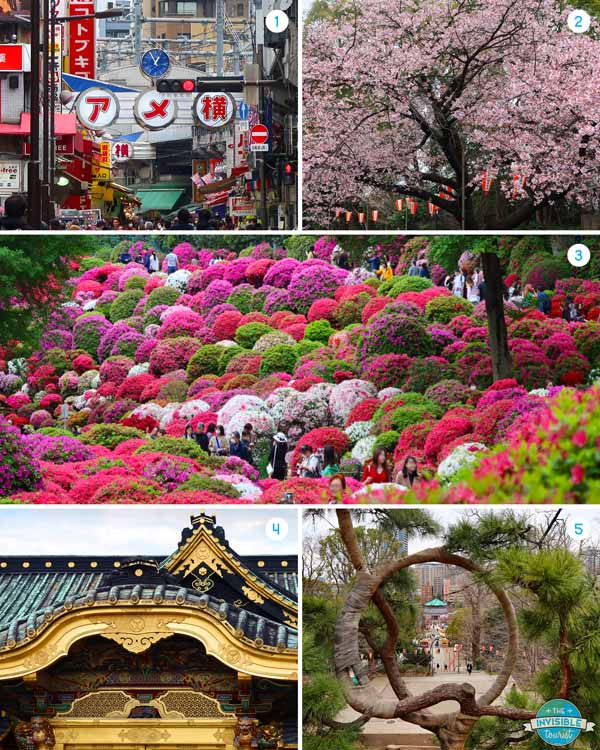
DAY 5: Southern Tokyo – Ginza, Minato, Odaiba
For day 5 of your Tokyo itinerary, you can explore the beautiful southern neighbourhoods of Ginza, Minato and Odaiba! BUT if you prefer to escape the bright lights and modern buzz, I have a quiet, Kyoto-like alternative down the page.
Things to do in Ginza
Wander the streets of Ginza 銀座 and admire the designer shops and funky architecture. Be warned, though – this is the upmarket area of Tokyo so naturally, prices here will be more expensive than elsewhere, but it’s still fun to explore nonetheless.
In saying that, I’ve got to admit the work-of-art architecture on the designer buildings keeps things interesting at least! Head to Laox to enjoy duty-free shopping on electronics and all kinds of Japanese souvenirs.
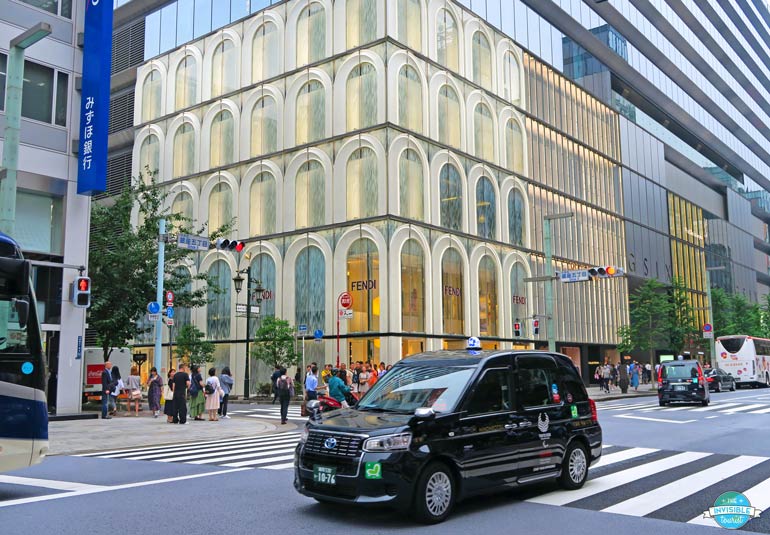
NOTE: Should you visit the nearby Imperial Palace East Gardens? I did visit on my first Tokyo trip. There is not an actual palace – just the moat, walls and entrance gates to the old Edo Castle remain. However, now that I’ve revisited Tokyo so many times, I wouldn’t say it’s really worth it. While it is free to enter the gardens, there are certainly other experiences I’d prioritise instead! Some of the surviving buildings can be found in Kawagoe instead.
TIP: Would you like to experience Kabuki Theatre during your time in Japan? Kabukiza Theatre here in Ginza is the place to do it! Kabuki is a traditional style of Japanese performance including beautiful costumes, makeup, singing and dancing. In 2008, Kabuki was granted UNESCO Intangible Cultural Heritage status due to its long history and significance in Japanese culture. Learn more and buy Kabuki tickets here.
Where to eat in Ginza
- Why not join an All-Star foodie tour around Ginza with a local guide and sample some seasonal dishes?
- If up until now you’ve been hesitant to try Japan’s national beverage, sake (pronounced sa-keh), this is your chance! Paired with local dishes, learn more about nihonshu (Japanese for sake) and taste different types of sake ranging from dry to sweet on a this wagyu beef & sake pairing tour in Ginza!
- Prefer not to try wagyu? This Japanese whisky, sake & cocktail tour in Ginza is a nice alternative.
- Kirin City is awesome too, there are several throughout Tokyo. You can order a Japanese version of tapas and enjoy it in the pub-like atmosphere. It’s a really enjoyable experience and you’ll find many locals there, which is always an excellent sign.
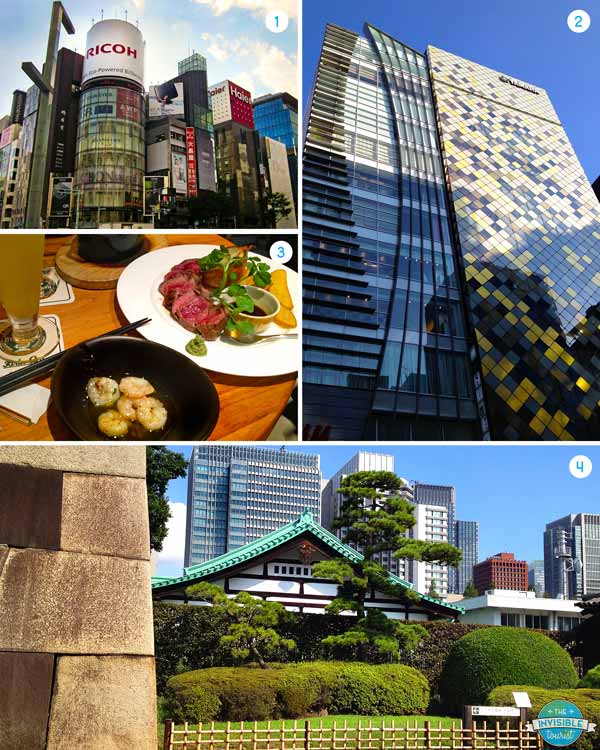
What to see in Minato
- You won’t be able to miss another icon of the city here, the Tokyo Tower. Did you know its orange and white frame is modelled loosely on the Eiffel Tower? You can also buy tickets in advance to skip the line at the Tokyo Tower Observation Deck!
- Afterwards, take a stroll around Shiba Park to the 17th century Zōjōji Temple 三縁山増上寺. Surrounded by beautiful gardens, a visit to this temple will pull at your heartstrings as the grounds are dedicated to thousands of Jizo, the guardian deities of children. Here they also act as a memorial for stillborn or miscarried babies. I couldn’t help but be moved as the number was overwhelming. Please, don’t be an annoying tourist here and act respectfully during your visit.
- Stunning Hamarikyu Gardens 浜離宮恩賜庭園 are also worth a visit in this area of Tokyo. The pine trees have been so meticulously pruned with care over the decades, they take on the appearance of giant bonsais! At these Edo-period gardens, you’re also able to enjoy drinking matcha tea in the traditional Japanese way on tatami mats at Nakajima No Ochaya teahouse.
- Hoping to wish for career success? Atago Shrine 愛宕神社 is a hidden gem overlooked by most visitors. With a rare golden torii and steep “success” stairs, this shrine has a fascinating back story! I’ve explained on my Instagram here.
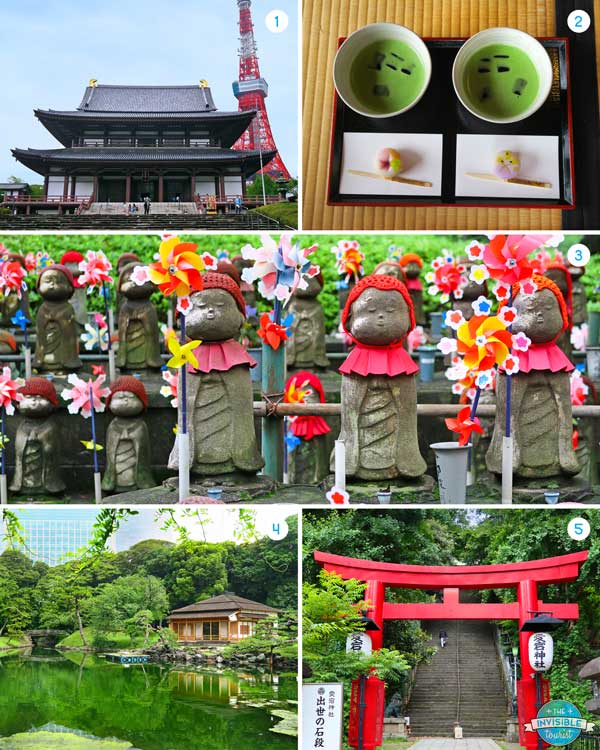
Things to do in Odaiba/Toyosu
- Love shopping? DiverCity is full of kawaii (cute) merch featuring your favourite Sanrio characters such as Hello Kitty, Gudetama and more. The Unko Museum (Japanese for poop) here is ok if you’re travelling with young kids, but otherwise not really worth it.
- Did you know Tokyo has its own version of the Statue of Liberty overlooking the Rainbow Bridge? See them on a clear day from the Fuji TV Headquarters observation deck.
- Odaiba is where the teamLab Borderless exhibition was (reopened in Azabudai Hills in February 2024), so now nearby Toyosu is hosting equally popular teamLab Planets, which is remaining open until 2027.
- Fancy taking a Sumida River cruise? It’s always a great idea to see a new city from a different perspective! Head from Odaiba to Asakusa and witness Tokyo from the water by booking your Sumida cruise tickets in advance. There’s also a Tokyo dinner cruise available!


Alternative to Southern Tokyo – Shibamata
About 45 mins by train north-east of central Tokyo lies a little-known old neighbourhood with an impressive ancient temple, street with traditional stores, retro toy museum and a beautiful preserved tea house. It feels a world away from modernity elsewhere.
Surviving the WWII air raids, Shibamata Taishakuten Temple is the star attraction here, its sprawling 500 year-old pine tree takes on the appearance of a flying dragon. The temple famed for dozens of intricate wooden carvings that date back four centuries.
Afterwards head to Yamamoto-tei, a former merchant’s home from the 1930’s with a stunning garden surrounded by a boardwalk. Enjoy wagashi and matcha whilst overlooking the lovely scenery.

DAY 6 – OPTIONAL: Day trip from Tokyo
To see Mt Fuji, Hakone is one of the most popular day trips outside Tokyo for foreign tourists. So much so, it has become quite overcrowded.
Tourists now spend hours queuing up to take photos at shrines, and for the transport options to get around… I probably wouldn’t recommend it these days if you’re not a fan of crowds!
While I’ve shared some day trip alternatives down the page, if you’re really wanting to visit Hakone these are my tips:
- The easiest way to plan your Hakone itinerary is to follow the Hakone Round Course with the Hakone Free Pass.
- It includes a combination of train, cable car, ropeway, boat and bus to see lakes, hot springs, active volcanos, art galleries and gardens. Highlights are the Picasso Museum, Open Air Museum and Mount Fuji (if she decides to peep out from behind the clouds!)
- For pricing and more information on the Hakone Free Pass, click here.
- If you’d like to try an onsen (hot spring), take a look at this Ryuguden Honkan experience in Hakone.
- Getting there: Tokyo Shinjuku to Hakone-Yumoto stations via Odakyu Express, approx 1h25.
- TIP: Sit on the right side of the Odakyu Express from Tokyo to get the best view of Mount Fuji as you speed past.

More day trips from Tokyo
TIP: There are more options to see Mt Fuji and other side trips. Be sure to read my full guide to day trips from Tokyo, detailing info about these spots and 18 alternative day trips I’ve personally undertaken.
- Nikko 2 hours from Tokyo
This stunning UNESCO World Heritage site is home to many temples and shrines (pictured below) nestled within nature’s finest scenery. There are 3 ways to get there, which I detail with plenty of tips in my guide to a Nikko day trip from Tokyo. If you wish to spend longer than one day, I’d recommend doing a self-guided trip exploring Tobu World Square , Edo Wonderland and alternative things to do in Nikko. - Kawaguchiko (Fuji Five Lakes) 2 hours from Tokyo
Fuji Five Lakes is simply stunning… Reflective lakes paired with a backdrop of Mt Fuji means you really can’t go wrong. Especially at the Fuji Shibazakura Festival at Fujikawaguchiko in May. Read my full review on what I believe is the best Tokyo to Mt Fuji day trip itinerary that covers a tea ceremony at Lake Kawaguchiko, sacred ponds of Oshino Hakkai, shopping at Gotemba Premium Outlets and more. But for the best views of Mt Fuji, I actually recommend Fujinomiya instead — it’s the unseen side of this sacred mountain. - Kawagoe 30 minutes from Tokyo
Preserved old-world town known as “Little Edo,” Kawagoe is one of my personal favourite day trips. Gorgeous architecture, sweet treats, awe-inspiring shrines and more, read my guide to a Kawagoe day trip itinerary for details. - Kamakura 50 minutes from Tokyo
With many temples and shrines, a Kamakura day trip is popular for its famous Buddha and easy hikes nearby. - Tokyo Disneyland & DisneySea 25 minutes from Tokyo
If you’re into all things Disney, these theme parks are the obvious choice for you. Don’t forget to book your Disney tickets in advance! - Nagano 3 hours from Tokyo
Known as being a ski town, Nagano sure does delight in the summer months, too! Here you can visit the Jigokudani Snow Monkey Park (and their newborn babies in summer), or combine this with a tour including sake tasting and a visit to Zenko-ji Temple. However, I do recommend spending 2 days in Nagano for reasons I mention in those articles.
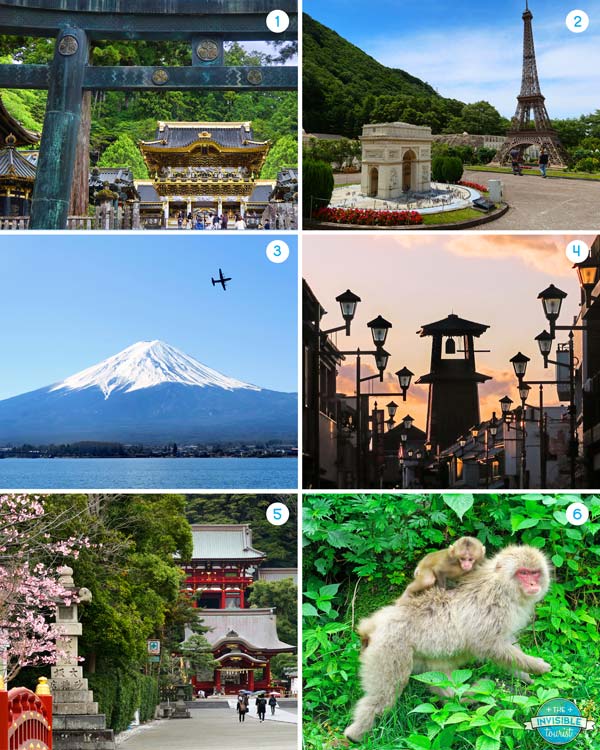
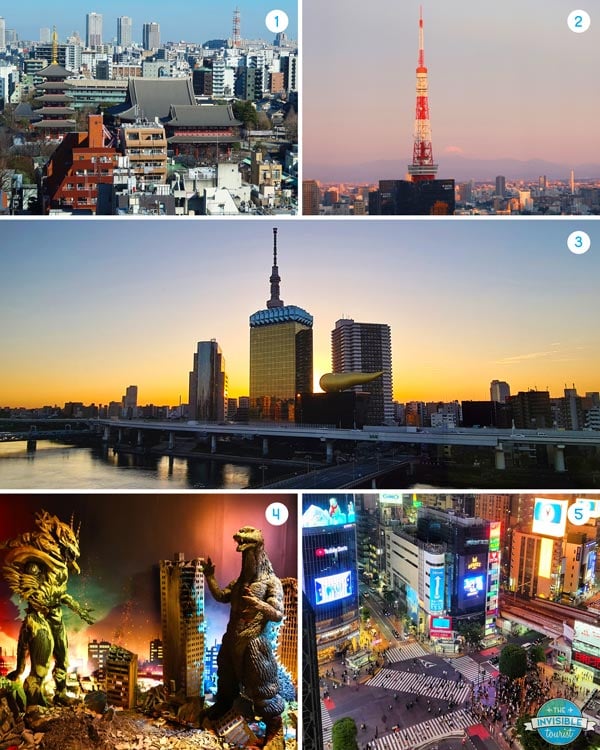
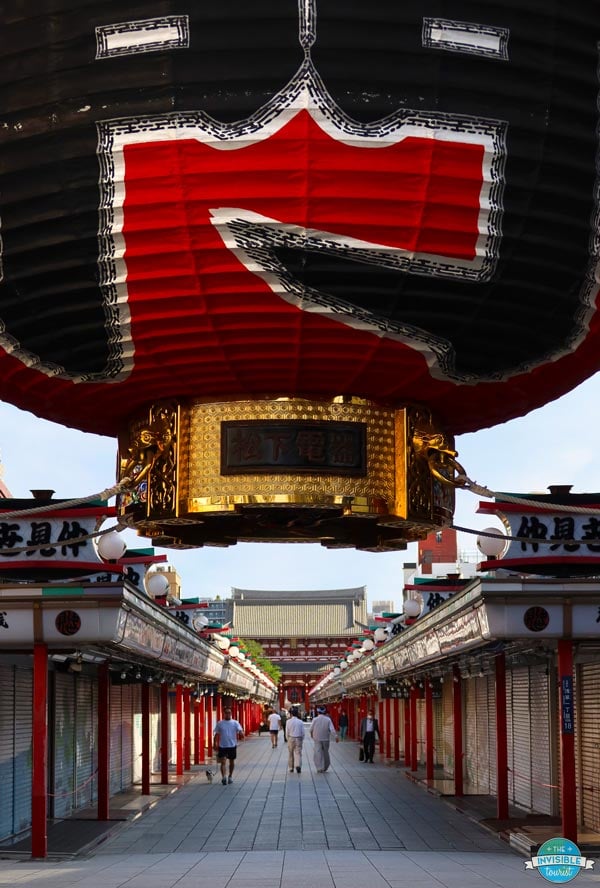
Things to do in Tokyo to customise your trip
Did you know there are some small, locally guided tours of each area you can add to your itinerary for Tokyo? These are a great way to meet people with similar interests during your trip and support local businesses.
Where to eat in Tokyo
I’ve taken numerous of these food tours and can definitely recommend each for discovering hidden spots only locals know about! For the full list including my reviews, please see my guide to 20+ food tours in Tokyo.
- Shibuya Street Food Tour →
This one was so fun! Get off the beaten path in this popular neighbourhood, visit 5 foodie stops & visit an underground food market only locals know about. - Shinjuku Night Foodie Tour →
If you’re anything like me and can’t get enough Japanese food, you won’t want to miss this experience! Eat your way through Shinjuku by sampling 10 different Japanese foods in the Golden Gai & Kabukicho areas. - Shibuya Ramen Tasting Tour → (use code Invisible5 for a discount!)
This is an incredible tour, turn up hungry! No trip to Tokyo would be complete without sampling ramen, enjoy tasting 6 different bowls of this delicious dish! Read my full Shibuya ramen tour review here. - Harajuku Crazy, Cute Kawaii Foodie Tour →
Here’s one for the kawaii fans! Learn more about Japanese kawaii culture, indulge in an array of cute sweets and see this trendy area of Tokyo like no-one else. - Tokyo tea ceremony & wagashi making →
I loved this fun experience making traditional Japanese sweets from a 5th generation tea master, then eating them during a relaxed tea ceremony. - Shibuya Bar Hopping Tour →
I have experienced this one too, it’s so much fun (read my detailed review for what to expect in Shibuya at night)! Lock in this enjoyable tour to experience nightlife in this exciting area. Enjoy delicious local cuisine and drinks at hidden izakaya pubs you wouldn’t find on your own (image below). - Shinjuku Bar Hopping Tour →
If you’re keen to have a fun night out in popular Shinjuku, this bar hopping tour takes you to some lesser-known gems so you can enjoy an authentic, local experience. - Sumo Wrestling & Lunch Experience Tour →
A must-do when in Tokyo. As the sumo tournament is only held 3 times per year in Tokyo, it’s easy to miss. Watching sumo perform is a great way to see them up close if your trip doesn’t coincide with the tournament. - Vegan Night Foodie Tour →
Because it can be difficult to find meals for vegans and vegetarians in Japan! - Try a Tokyo cooking class →
While I’ve done a ramen cooking class in Kyoto, you can participate in classes in a local’s home or in a restaurant setting. There are hundreds of options to create all kinds of dishes from sushi to gyoza, mochi to wagashi and many more.
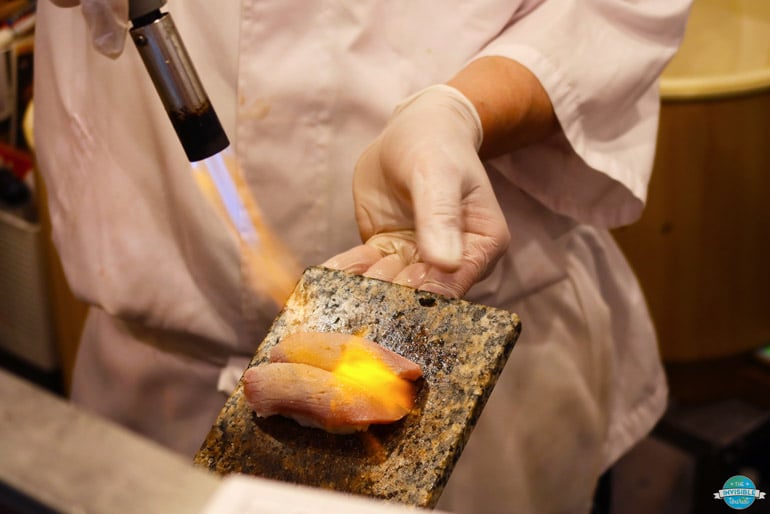
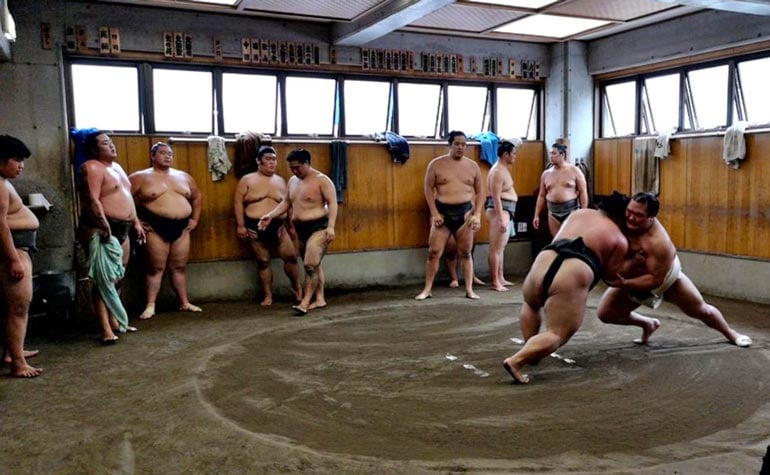
Things to keep in mind when planning a Tokyo itinerary
Here are some things to note about transport, buying tickets in advance, plus some more useful resources when planning a Tokyo itinerary.
IC Cards, Japan Rail Pass & Shinkansen (Bullet Trains)
Contrary to popular belief, you DO NOT need to buy a Japan Rail Pass before you visit, especially if you’re travelling with a mid range budget.
Find out why in my guide to how to catch the shinkansen in Japan which also explains the differences between transport passes in Japan and ways to save money.
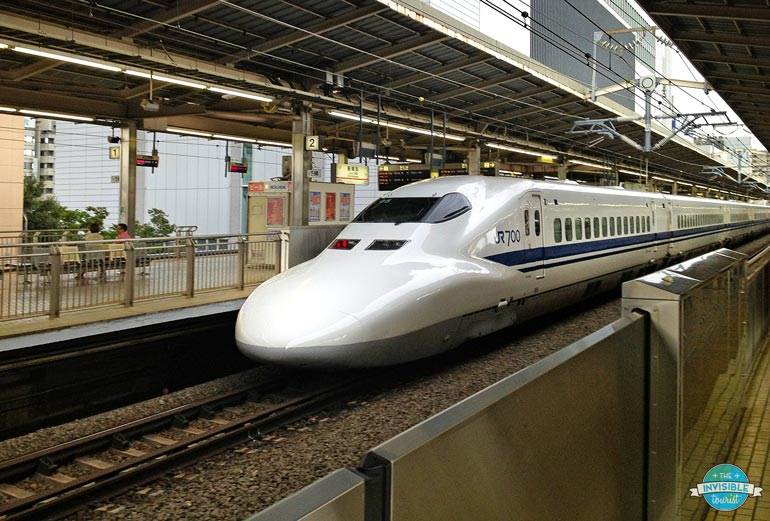
Here are more resources for your Tokyo trip:
- More about Suica, Welcome Suica & IC cards over on my Instagram highlight.
- Here’s what to pack for Japan and save my handy packing checklist to reference later.
- Find out the many do’s and don’ts to follow in Japan regarding cultural etiquette so you can travel confidently.
- Learn 20+ crucial travel tips and how to prepare for your trip in my detailed Japan travel planning guide.
- Save up to 62% on entry to popular attractions with the Tokyo Fun Pass.
- Did you know you can book pocket wifi in advance? It’s quite cheap and you’re able to pick it up from an airport of your choice when you arrive. Pre-book pocket wifi hire and read my guide about how to rent wifi in Japan for tips. Some folks also prefer to buy local SIM cards.
- Tickets for Shibuya Sky, teamLab Planets, Art Aquarium Museum, Tokyo Disneyland & DisneySea, Studio Ghibli Museum, Tokyo Tower Observation Deck, Sumo Tournament and many more passes can be purchased up to 8 weeks in advance online. This will save you loads of hassle and wasted time lining up when you’re there! I’ve written in detail the answer to “is Klook legit?” if you want to learn more.
- For my fellow book lovers, I created this itinerary with some of my favourite Japan travel books.
- Want to learn Japanese? My guide to Japanese for tourists includes a free PDF cheat sheet of all the words you’ll need! Alternatively I have tried and recommend online courses, my Japanese With Hikari review has the details.
Concluding what to do in Tokyo in 5 days (or 6 days)
Now you know how to plan a trip to Tokyo that includes sights and experiences that best suit your interests! Switch out some of the popular locations with my alternatives, and enjoy some fun experiences with locals to enrich your trip. It will be so much more fulfilling and rewarding than spending a chunk of time queuing up for photos!
I’m not sure why some people choose to spend only 2 or 3 days in Tokyo when there are so many different neighbourhoods to explore and sights to see. Take the extra time, add another few days to your Tokyo itinerary and allow yourself to really experience this awe-inspiring city in the way it deserves. Why rush? You’ll thank yourself for it later.
As I’m sure you’ll agree, there was a LOT of walking in this first time Tokyo itinerary, but it’s handy to know that the city’s extensive public transportation options are always nearby if you wish.
Love this Tokyo neighbourhood guide? You may also enjoy my other expertly-curated guides to help you “blend in” in Japan:
- 4 days in Kyoto itinerary for first time visitors
- 3 days in Osaka itinerary for first time visitors
- Day trip to Nara itinerary
- Meaningful & fun things to do in Hiroshima
- Miyajima day trip by ferry: 3 ways to get there compared
- 7 days in Kyushu itinerary: Underrated island region
- 7 days in the Izu Peninsula itinerary
- 10 days in Japan itinerary to avoid crowds
- 10 day romantic Japan honeymoon itinerary
- Hidden gems in Japan off the beaten path
- Onsen ryokan & hotels in Izu Paninsula: Overlooked Hakone alternative
If you found this Tokyo in 5 days itinerary helpful or know someone who is planning a trip to Japan, please share it around as it really helps me in return!
You can also come and join me on Facebook, Pinterest, YouTube, Instagram and TikTok for more Japan inspiration!
Until next time,

Do you love Japanese sweets, snacks and candies?
Read my Tokyo Treat Review and get popular Japanese snacks delivered here, or read my Sakuraco review and get traditional Japanese sweets delivered here!
Like it? Pin it!

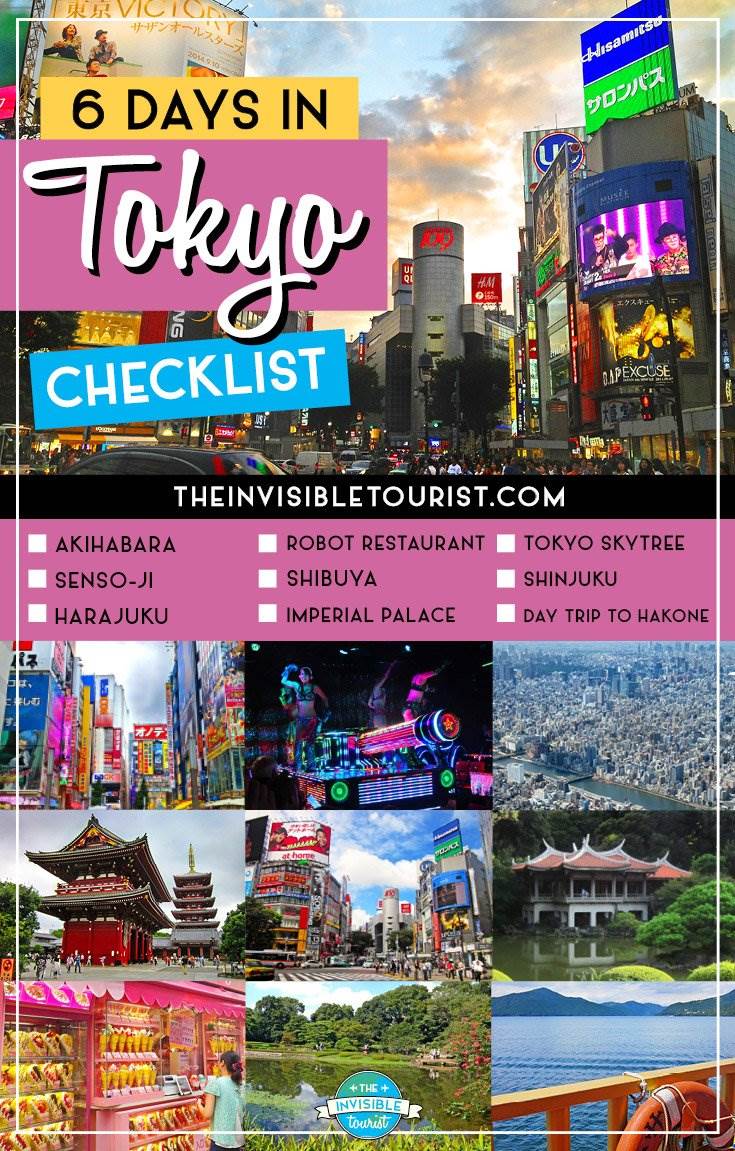
This guide to a 6 day Tokyo itinerary contains some affiliate links, at no extra cost to you. I may earn a small commission if you decide to make a purchase and if you do, thanks for your support! This helps with the costs of running my blog so I can keep my content free for you. As always, I only recommend a product or service that I genuinely love and use myself!


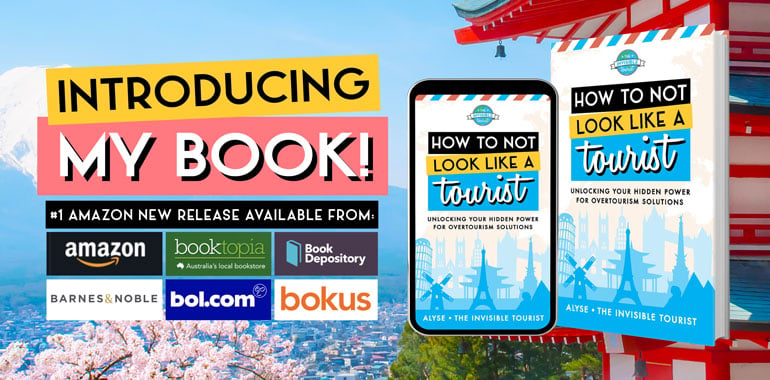
Fantastic content. I am pretty much using your footprints to plan our Japan trip. Where would you add Teamlab Borderless and Harry Potter in your Tokyo itinerary. Thank you again for great information and your help
Hi Samir!
For teamLab, it would be easy to add into a morning or afternoon on Day 5 as I suggested in the itinerary 🙂
If you wanted to also include the Harry Potter experience, I’d start with that first thing in the morning, then do teamLab in the evening. That way you have plenty of time to get between each experience, and aren’t sacrificing part of another day 🙌
I hope that helps and you have a great trip!
Great article!
I looked at both your articles to buy a Suica and a 24/48/72 hour Tokyo Metro card – are these two separate cards? Do you recommend getting both? And when would I use each? Thank you!
Thanks, Kelsey!
Yes, they’re separate cards. You can recharge a Suica but not the Subway Pass, which expires after the number of hours you purchased it for.
I’ve detailed more info here on my Instagram that answers all your questions 😊
Thanks for reading and I hope you have a great time in Tokyo!
My dream is to make this trip, congratulations for the content here – João Brasil 🇧🇷
Thanks so much, Joao! I hope your dream to visit Tokyo comes true soon 😃
I looked through the information on this site and think it is useful. Ordered the book. My critique is there is no information on goint to a Kabuki performance. I had been to Kabuki severl times when I lived near Tokyo in the mid 1960s. Kabuki is an extrordinary theatre and gave me insights into japanese people and their culture.
Thanks for your comment, L. V. Vincent 😊
That’s so wonderful you had the chance to enjoy Kabuki during your time in Tokyo. I’ve never been but would love to someday!
I’ve updated the article under the Ginza day to include where my readers can find information about Kabuki theatre and how they can buy tickets.
Thank you for the suggestion and I hope you find my book useful, too!
I’ve been gathering tips & tricks, food and activity recommendations, etc. for the past two weeks and this guide was great! I added a few items to my list and it was nice to see others recommendations I’ve jotted here too. Thanks for the great content, looking forward to checking out your other posts about Japan!
I’m so happy to hear that, Shelli! I hope you enjoy my other popular articles and itineraries for Japan, and they help with your planning 😃 Thanks so much for your comment!